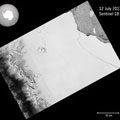Over the last few months, a chunk of Antarctica's Larsen C ice shelf has been hanging on precariously as a deep crack cut across the ice. Witnessed by the Copernicus Sentinel-1 mission, a lump of ice more than twice the size of Luxembourg has now broken off, spawning one of the largest icebergs on record and changing the outline of the Antarctic Peninsula forever.
Over the last few months, a chunk of Antarctica's Larsen C ice shelf has been hanging on precariously as a deep crack cut across the ice. Witnessed by the Copernicus Sentinel-1 mission, a lump of ice more than twice the size of Luxembourg has now broken off, spawning one of the largest icebergs on record and changing the outline of the Antarctic Peninsula forever.
The fissure first appeared several years ago, but seemed relatively stable until January 2016, when it began to lengthen.
In January 2017 alone it travelled 20km, reaching a total length of about 175km.
After a few weeks of calm, the rift propagated a further 16km at the end of May, and then extended further at the end of June.
More importantly, as the crack grew, it branched off towards the edge of the shelf, whereas before it had been running parallel to the Weddell Sea.
With just a few km between the end of the fissure and the ocean by early July, the fate of the shelf was sealed.
